It is a beautiful place to visit any time of the year, but Québec City in the fall is quite breathtaking. The parks and enchanting riverscapes are ablaze with vibrant autumnal colors, and cooler temperatures make it the ideal time for strolling or cycling around the city’s atmospheric French quartiers.
Perched above the mighty St. Lawrence River, Québec City is one of the oldest European cities in North America. At its center is Old Québec, founded in 1608 and surrounded by 400-year-old fortified walls and ramparts.
Charming 17th- and 18th-century houses line pretty town squares and narrow cobbled streets; when you stop at a café and hear French being spoken all around you, it’s just like being in a town in the heart of France.
If you’re looking for a dose of joie de vivre on this side of the Atlantic, here are nine delightful things to do in Québec City in the fall.
The Weather Is Perfect for Walking
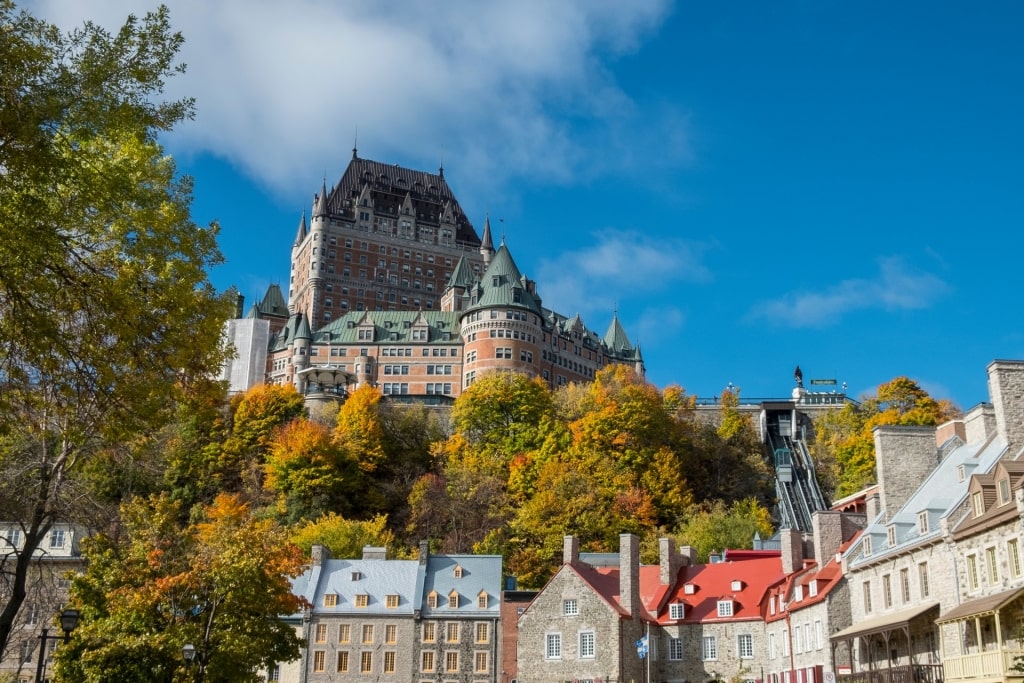
Old Québec
The historic district of Old Québec, designated a UNESCO World Heritage site in 1985, covers about half a square mile. And because the weather in Québec City in the fall is generally pleasantly cool, exploring on foot is the way to go—bearing in mind that there are numerous steep stairways linking Lower Town (Basse-Ville) and Upper Town (Haute-Ville).
Taking the funicular that runs up the escarpment between Lower and Upper Towns is an easier option and the city and river views are worth the ride alone.
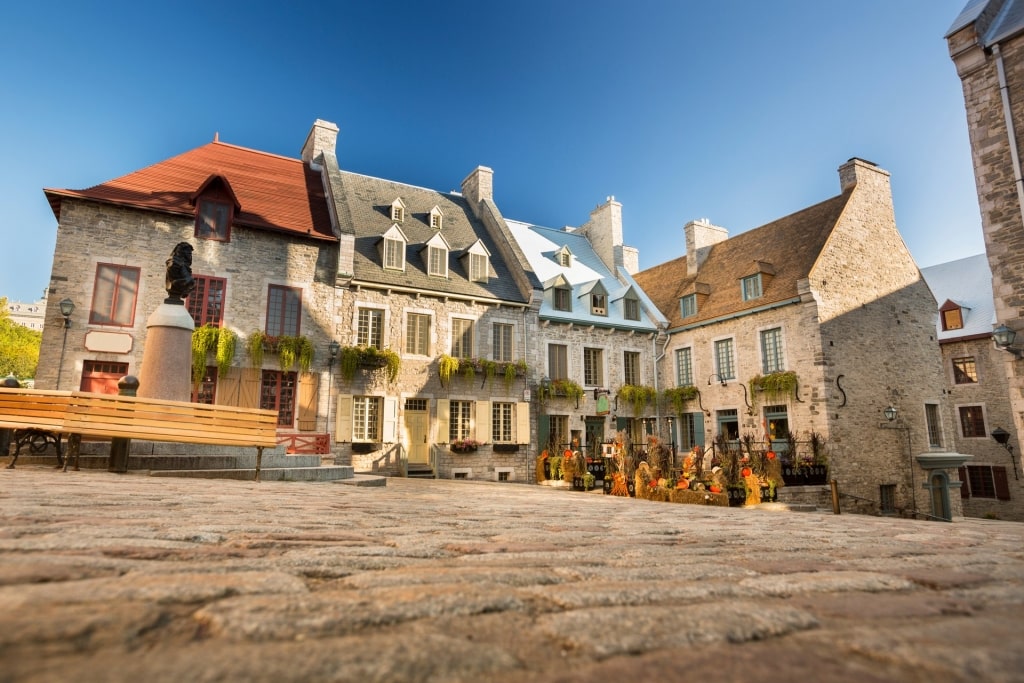
Place Royale
French explorer Samuel Champlain settled the Lower Town area in 1608 on the banks of the St Lawrence River—Place Royale is where his original “habitation”, the first permanent French establishment in North America, was built.
As the settlement expanded, Upper Town was developed as a defensive site because of its strategic position at the top of Cap Diamant.
It’s not hard to get oriented when you’re here. Lower Town comprises the area around Place Royale, the Petit Champlain shopping district and the Old Québec City Port, with St. Charles River to the north and St. Lawrence River to the east. The renowned Musée de la Civilisation and Naval Museum of Québec are also located in Lower Town.
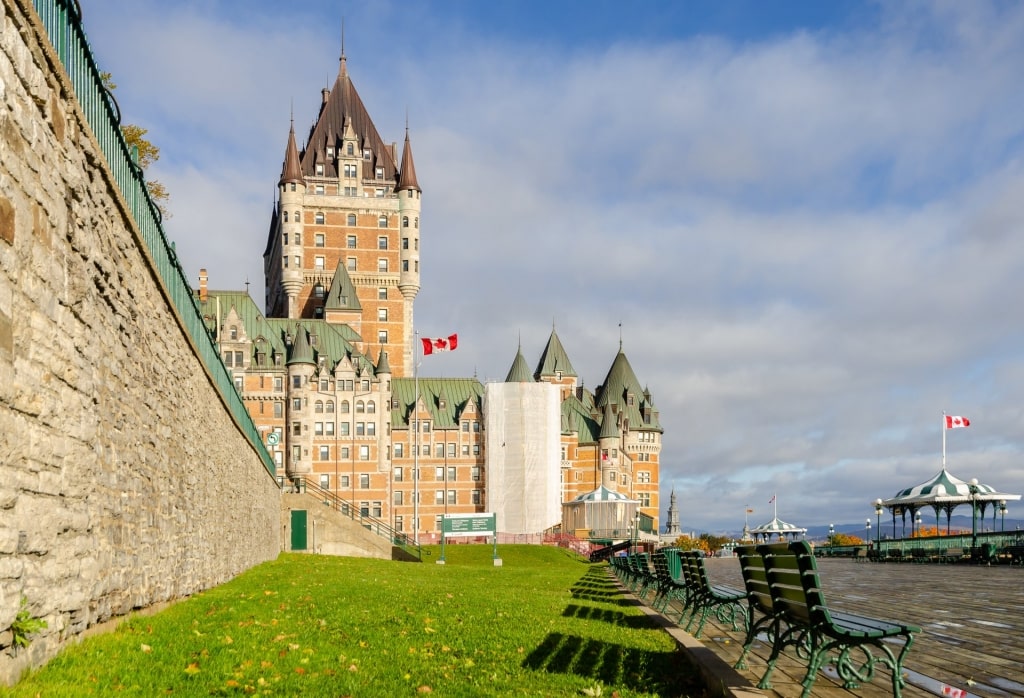
Upper Town
The Upper Town, which sits at the top of Cap Diamant, is the fortified area, which incorporates the Citadel fort, the unmistakable Château Frontenac hotel and Terrasse Dufferin, a boardwalk that overlooks the whole city.
Outside the city walls are the sweeping Plains of Abraham and the imposing Parliament building.
You’ll Have Ancient Churches to Yourself
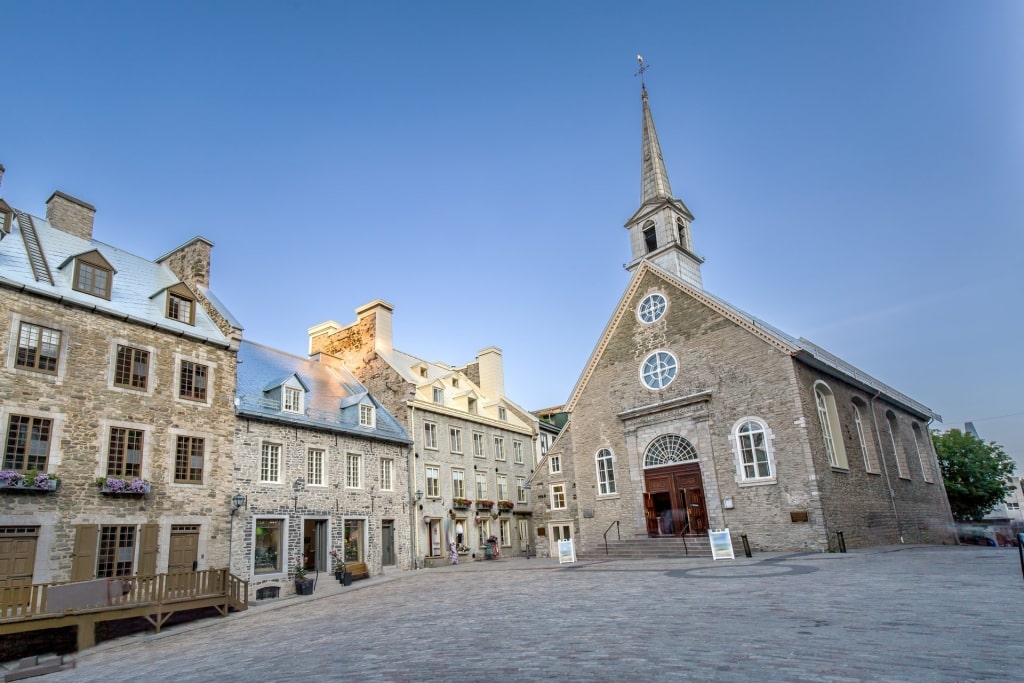
Notre-Dame-des-Victoires
While you’re exploring Old Québec’s Lower Town, have a look inside Notre-Dame-des-Victoires. It’s one of the oldest churches in North America and while not as grand as Notre-Dame de Québec Basilica-Cathedral, its history gives an interesting insight into the lives of everyday Québec citizens over the past 300-plus years.
Construction of the small stone church began in 1688, as a secondary place of worship to Notre-Dame de Québec Basilica-Cathedral because parishioners were unable to reach the Upper Town cathedral during the harsh winters to attend mass.
Québec City in the fall is considerably more congenial for the contemporary visitor—and you won’t be sharing these ancient buildings with the summer crowds.
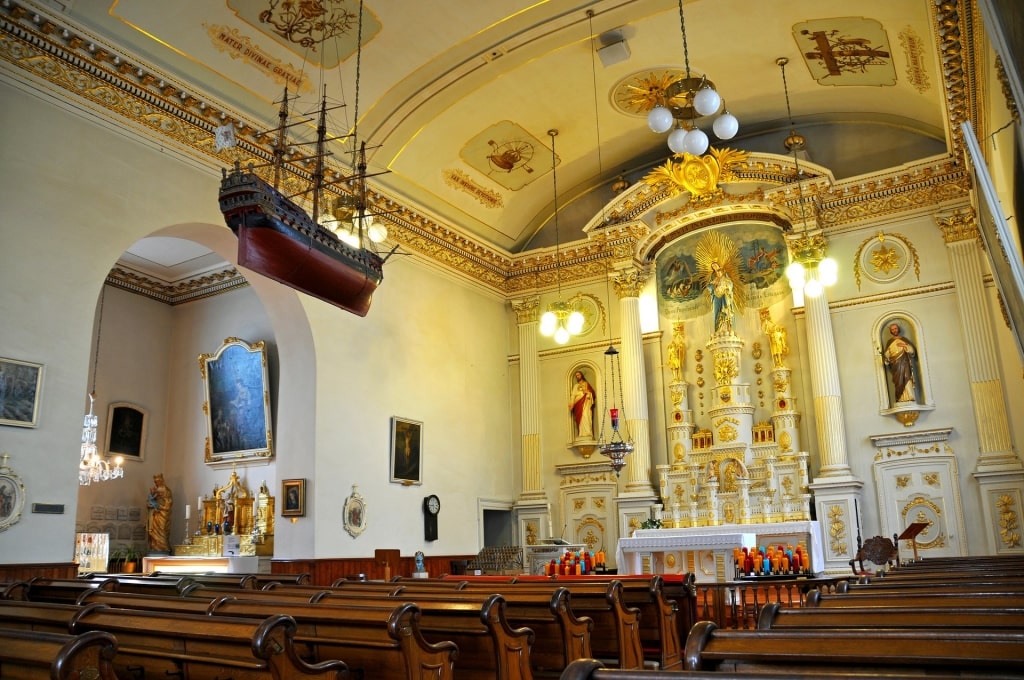
Notre-Dame-des-Victoires Photo by Dennis Jarvis on Flickr, licensed under CC BY-SA 2.0
Built over the ruins of Champlain’s 1608 habitation on what is now known as Place Royale, the church underwent destruction, restorations and a couple of name changes between the 17th and 18th centuries. Note for military history buffs: the church was named for the two French victories over British fleets in 1690 and 1711.
Today, the church’s understated interior is thought to be much as it was in the 18th century. It is not just a museum piece—Notre-Dame des Victoires attracts many faithful worshippers, and visitors will appreciate the sense of peace and continuity it represents.
You’ll Have Plenty of Energy for Shopping
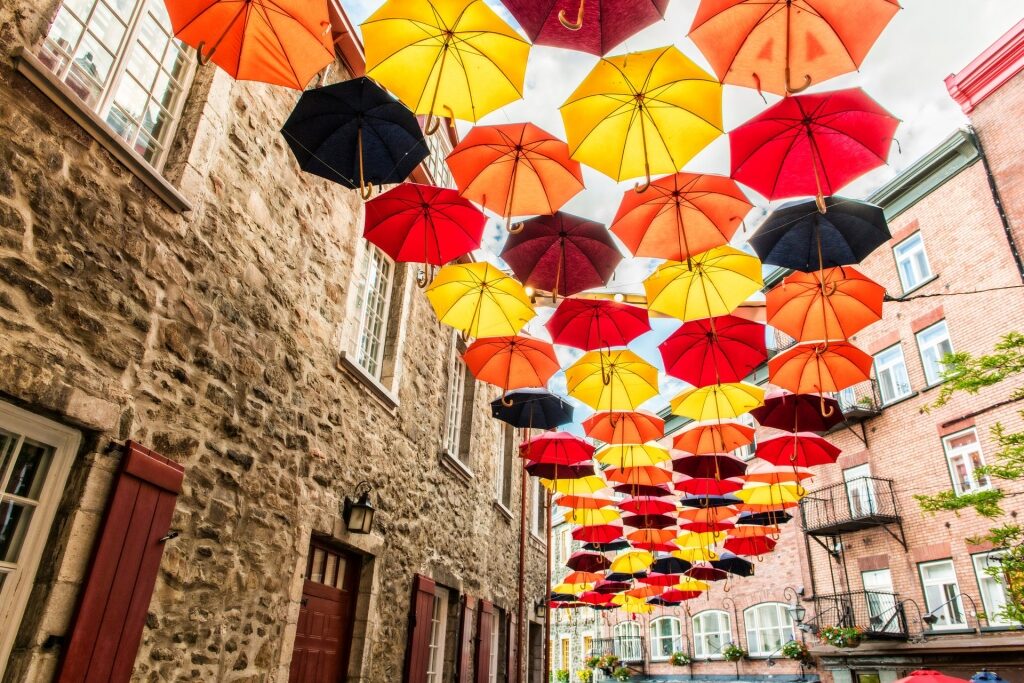
Rue du Petit Champlain
Navigating the tempting boutiques, cafes and galleries strung along picturesque Rue du Petit Champlain and other streets in the Petit Champlain district is much easier in the fall than during summer and winter, when crowds are at their peak, and the weather can be either too hot or bitterly cold.
Rue du Petit Champlain claims to be one of the oldest shopping streets in North America, and it must be the most photogenic. A huge mural at the foot of Breakneck Steps—which lead to Upper Town—depicts everyday scenes of Petit Champlain and Old Port over the centuries.
Life was certainly much harder back then, and Petit Champlain was severely damaged by rock falls in the 19th century.
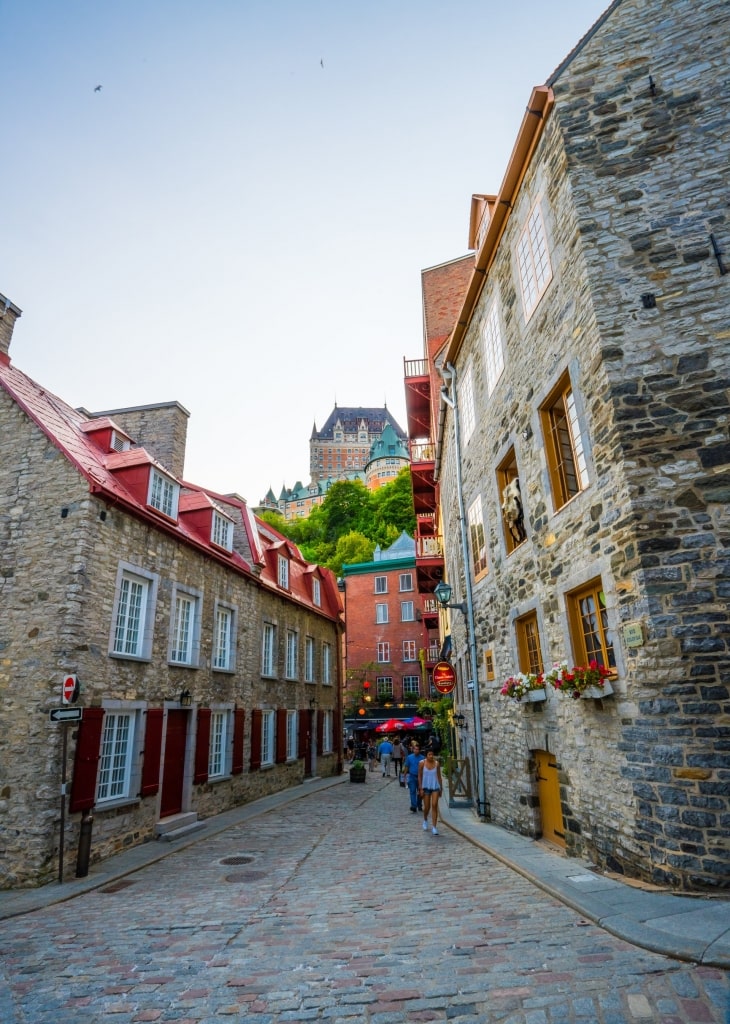
Rue du Petit Champlain
It’s hard to believe that in the 1960s the area was so run-down that the authorities considered razing it to the ground. Thankfully, two visionary architects spearheaded a revitalization project that led to the vibrant place we see today.
The beautifully restored heritage buildings, once home to fur traders and maritime artisans such as sailmakers, are now collectively owned and run by a co-operative of contemporary artists and craftspeople that is dedicated to preserving the district’s character.
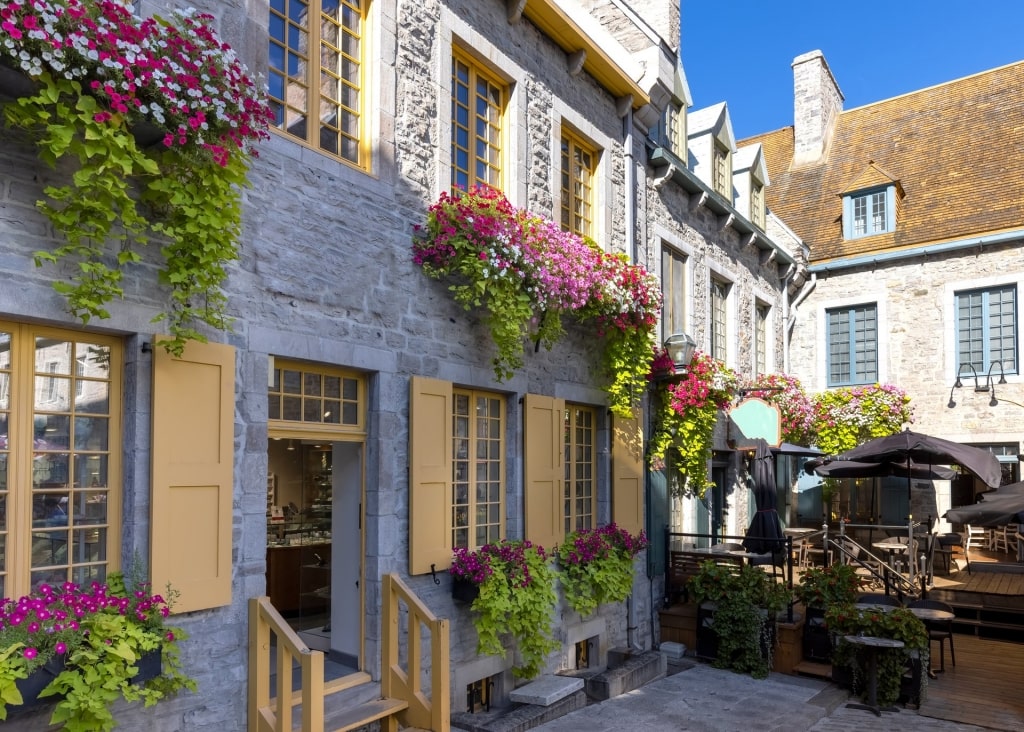
Rue du Petit Champlain
Enjoy a couple of hours of leisurely browsing as you wander from boutique to gallery to bistro. You’ll find fashions and accessories created by local designers, handmade jewelry, Indigenous sculptures and handicrafts, homewares, and original artworks.
Admire Iconic Buildings Bathed in Golden Light

Fairmont Le Château Frontenac
The gloriously extravagant Fairmont Le Château Frontenac is said to be the world’s most photographed hotel. She is the undisputed grande dame of Canada’s 19th-century grand railway hotels and shows her best face in the golden light of fall—so take your time finding the best angle for your own photo collection.

Fairmont Le Château Frontenac Photo by TravelingOtter on Flickr, licensed under CC BY 2.0
Non-resident visitors can join a hotel-run tour inside the Château to learn about the events and famous guests that have contributed to its history—or why not book in for a lavish afternoon tea if you’re there on a Saturday?
You can take a peek at the collection of memorabilia in the elegant lobby and while you’re there, say hello to the adorable resident Canine Ambassador, Jasper.
The hotel was designed by American architect Bruce Price, who favored the château-style of architecture popular at the time, and built by the Canadian Pacific Railroad Company in 1893.
It was named after Louis de Buade, count de Palluau et de Frontenac. He was governor-general of the New France colony from 1672 to 1682, and again from 1689 to 1698. Frontenac built Québec City’s first protective wall in the late 17th century at the site of the Citadel, which is about 15 minutes’ walk from the Château.
You Can See the Changing of the Guard at the Citadel
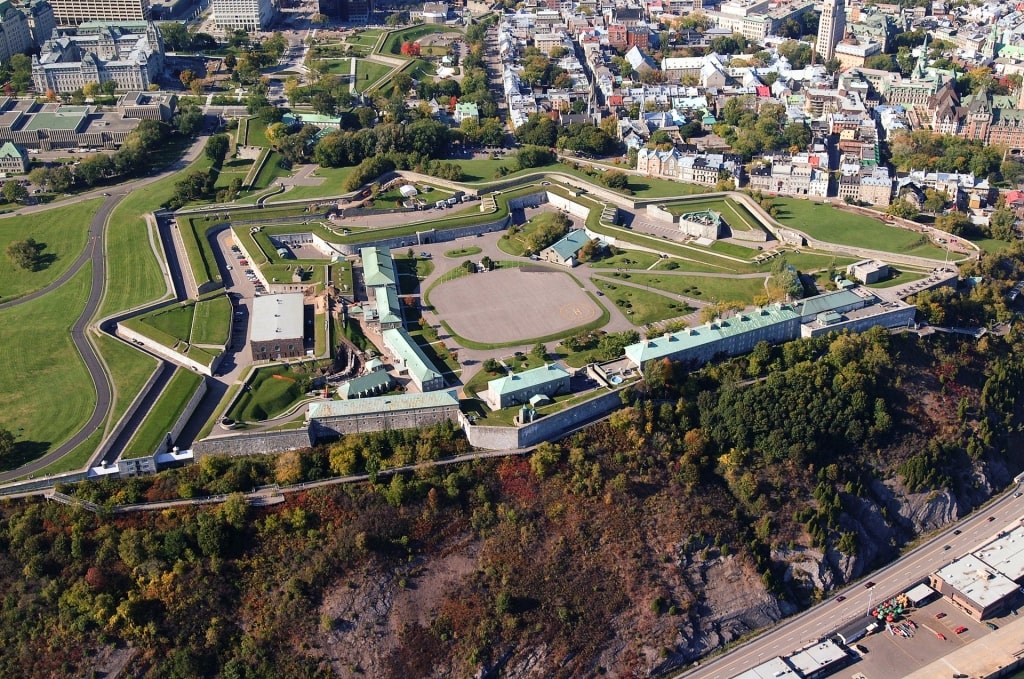
Citadel
Built over a period of 30 years, the impressive star-shaped Citadel has been an active military site since 1850. It housed British troops and the Canadian Royal Artillery until 1920, when the current incumbents, the Royal 22nd Regiment of the Canadian Armed Forces, were first stationed there.
The Citadel has also been an official residence for the governor-general since 1872 and now hosts international conferences and ceremonial events.
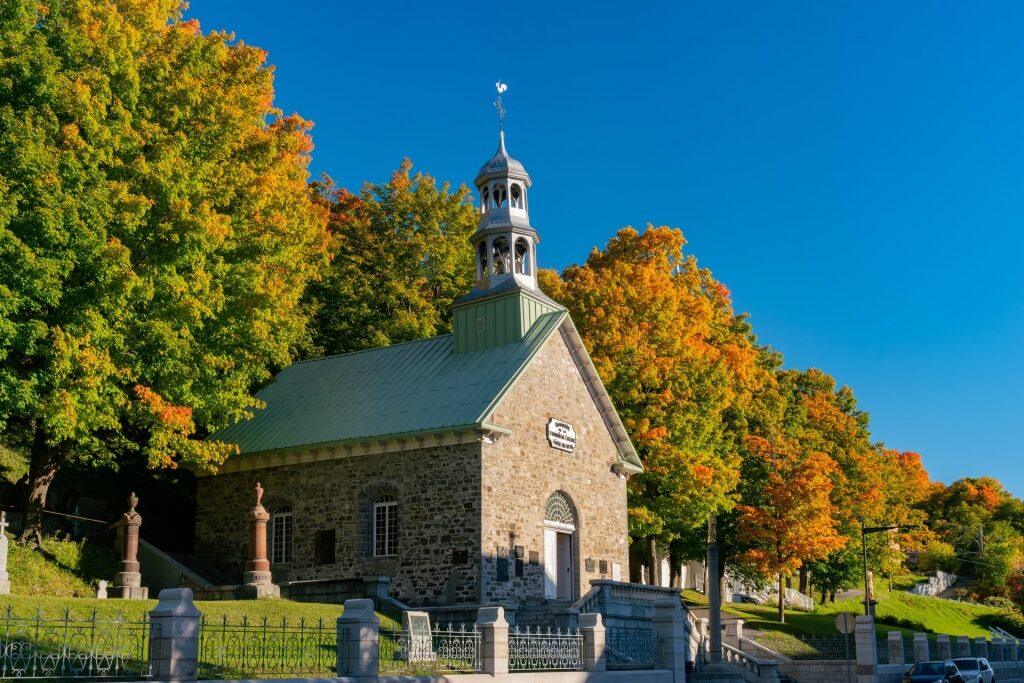
Citadel
Although the Citadel is still a functioning military base, you can join guided tours hosted by soldiers in the Royal 22nd Regiment—the only French-speaking regiment in the country.
Within the walls you’ll see a number of significant historic buildings, including the oldest French military building that Canada is known for, dating from 1693, and the governor general’s residence.
The on-site museum has a remarkable collection of military artifacts, relating to the careers, lives, and stories of soldiers from the 17th century to the present day. From summer through early fall, you can witness the daily changing of the guard ceremony—blink and you’d think you were at Buckingham Palace.
Taste Delicious Seasonal Produce
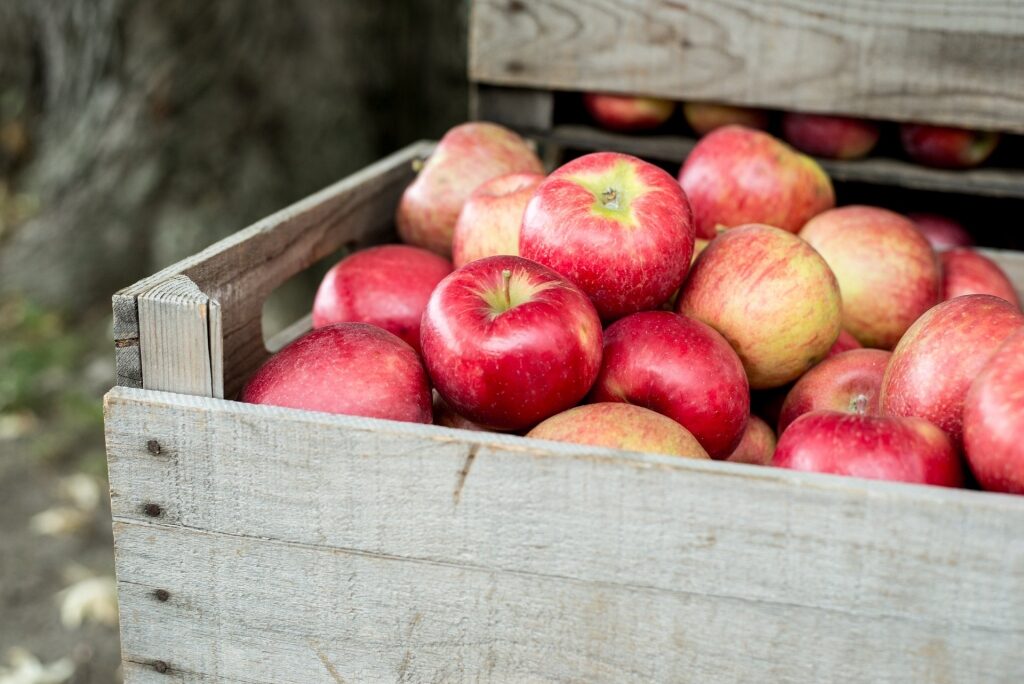
The residents of Québec City are well-known for their love of good food. A lot of seasonal produce is bought by chefs and home cooks come from Île d’Orléans, an island in St. Lawrence River that’s just 15 minutes’ drive from the city.
Fall is when autumnal fruits and vegetables are harvested, and it’s the best time to visit Canada for the island’s wineries, cideries and artisan cheesemakers.
A guided culinary tour is a delicious way to taste your way around the city. Québecois cuisine incorporates influences that range from First Nations foods to traditional French fare, British comfort food and “boreal cuisine”. This includes ingredients such as balsam fir, green alder pepper, sea buckthorn and honeyberries from Québec’s boreal zone.
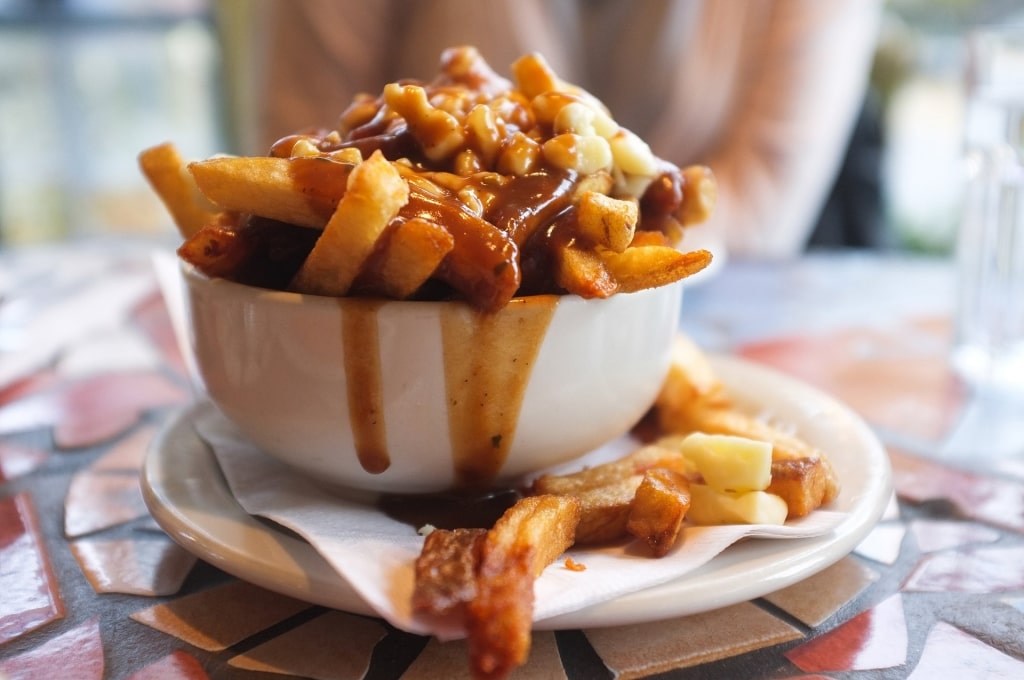
Poutine
Poutine is probably the best local dish that Québec is known for. It doesn’t look particularly appetizing but this hearty snack, made from fresh-cut French fries topped with cheese curds and gravy, is hugely popular throughout Canada. And if you haven’t been to a sugar shack, this is your chance to experience everything to do with sweet maple treats.
The Air Is Cool and Clear
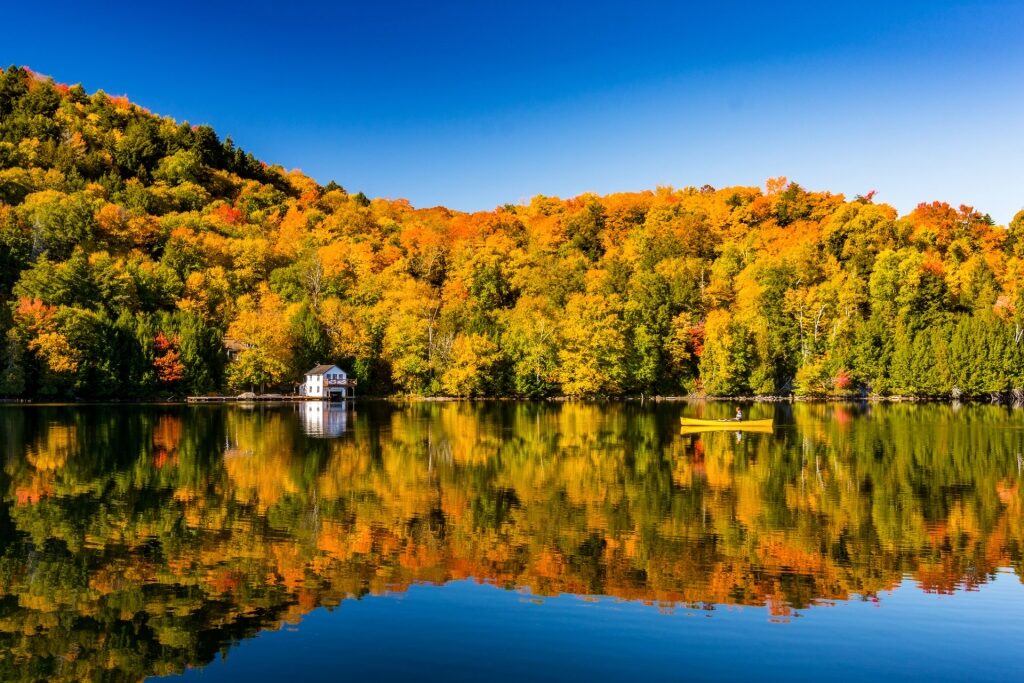
St. Lawrence River
Québec City in the fall is at its most beautiful when viewed from a boat on the St. Lawrence River. During the day, you’ll have uninterrupted views of Old Québec, Cap Diamant and Montmorency Falls, highlighted by spectacular fall foliage. An evening cruise reveals the city in all its romantic, sparkling glory while you indulge in a three- or four-course dinner.
There are several boat tours from Québec City that include narrated histories about the river’s geographic and economic importance. The quickest journey is the Québec-Levis ferry crossing that connects the north and south shores of the St. Lawrence River—it takes about an hour for the round trip.
More energetic river outings on offer include zodiac trips from companies based at the Old Port, and guided sea kayak tours around Île d’Orléans.
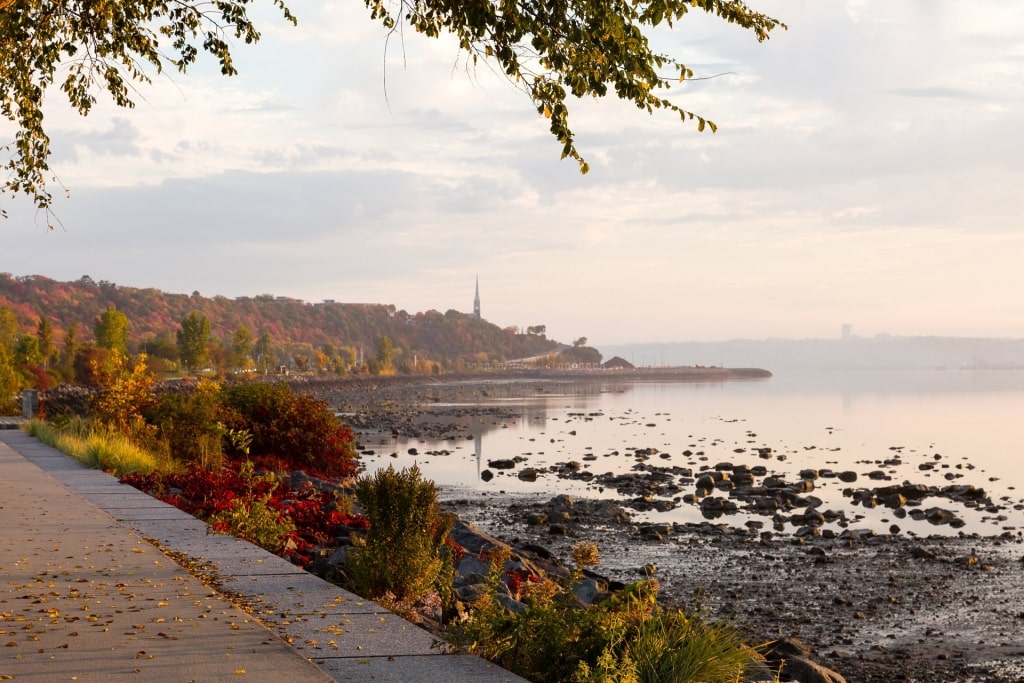
Promenade Samuel-De-Champlain
Cycling or walking along Promenade Samuel-De-Champlain is a great way to incorporate a little exercise with up-close river views in the fall light.
Interpretive paths run through themed gardens in the riverside park, and there’s an observation tower and a lookout on the one-and-a-half-mile promenade where you can stop for photo opportunities.
Read: Best Things to Do in Quebec City
You’ll Be Wowed by Dazzling Foliage
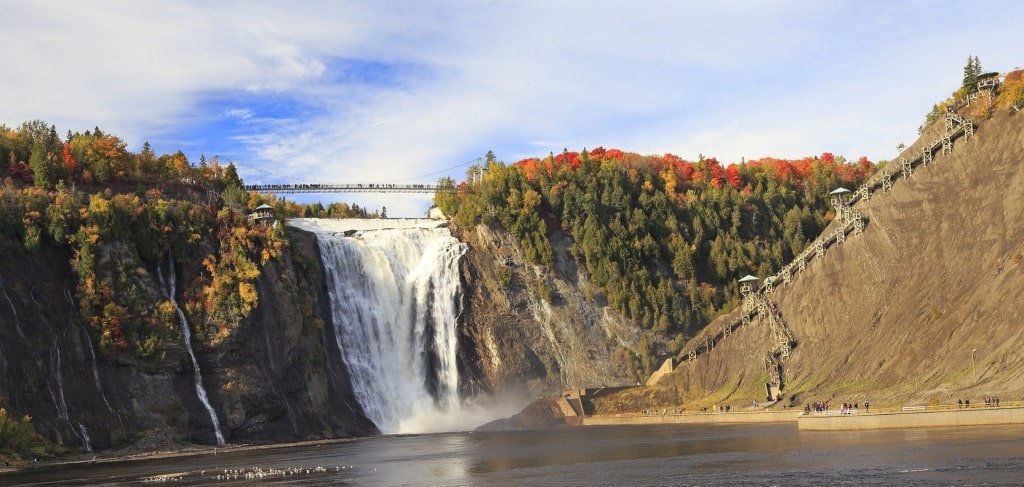
Montmorency Falls
Montmorency Falls is an astonishing natural attraction within easy reach of downtown Québec City—a mere 15-mile round trip by road. The Falls plunge some 275 feet from the Montmorency River into the St. Lawrence—that’s nearly 100 feet higher than Niagara Falls.
While the Falls and surrounding wild parkland are spectacular at any time of year, the rich russets and golds of the trees in fall add another wow factor to this majestic site.
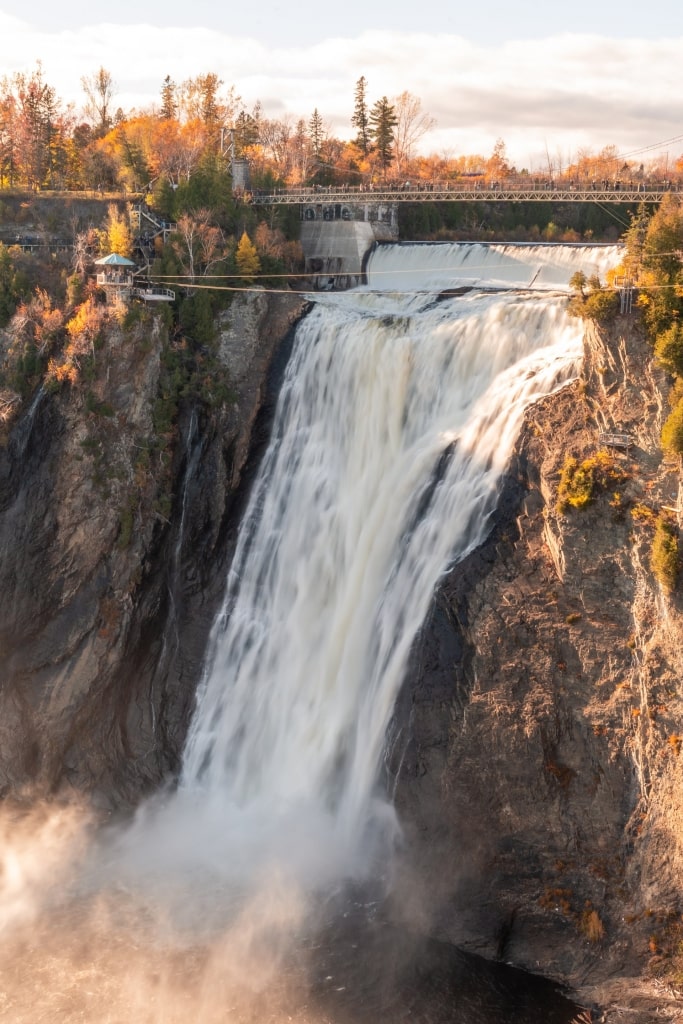
Montmorency Falls
There are a few different ways to find the best vantage points for viewing the falls. Easy walking trails of varying lengths run through the park, or if you’re feeling fit you can climb the 487-step panoramic staircase.
The cable car whisks you from the foot of the waterfall to the top, where you can walk above the roaring river on a suspension bridge, or get a bird’s eye view from the zipline. Serious adventurers can tackle the Via Ferrata, a hybrid of hiking and rock climbing that involves traversing the rock wall.
While at the top of the falls, it’s worth making a quick visit to the interpretation center inside Manoir Montmorency. You can learn about the history of the house and local area and the famous White Lady legend.
Evenings Are Perfect for Sidewalk Dining

Grande Allée
Evenings in Québec City in the fall are comfortably cool, ideal for exploring after dark. Grande Allée, an elegant avenue in the Montcalm district, is one of the city’s favorite nightlife hubs.
Many of the gorgeous Victorian-era buildings have been converted into restaurants, microbreweries, bars, and dance clubs. Music fills the air and the sidewalks are filled with alfresco eateries and people out for a good time.
Grande Allée runs by or is only a block away from several major attractions, including the Plains of Abraham, the Musée National des Beaux-Arts and the Parliament Building.
If you’re looking for a fine-dining experience, two of the best-known restaurants in the area are Ophelia, for sophisticated surf and turf, and Louis Hébert, an elegant establishment that specializes in French cuisine and has a much-awarded wine cellar.
L’Atelier is known for its creative cocktails and Le Dagobert is something of an institution for dedicated night owls. There are plenty of choices for craft beer aficionados, and fans of folk music should check out Les Voûtes de Napoléon.
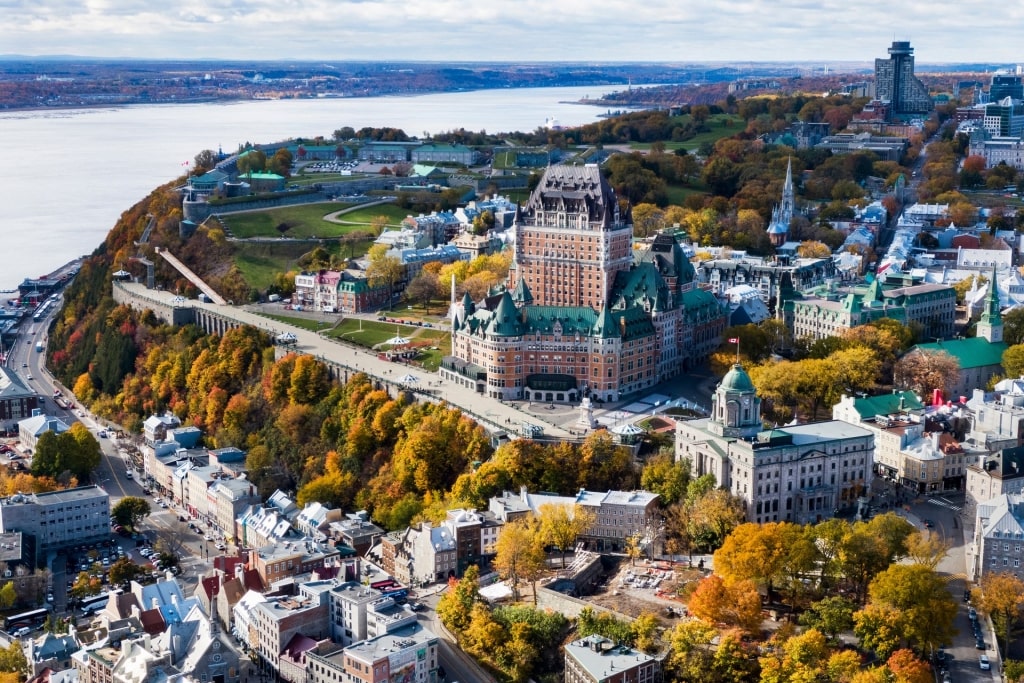
Quebec City
A cruise is the perfect way to experience Québec City in the fall. Browse our cruises to Quebec City and plan your vacation today.



